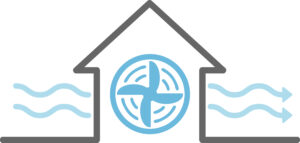Balanced Ventilation is Essential for a Healthy ICF Home
Insulated concrete form (ICF) construction creates superior homes that are incredibly energy-efficient. Because ICF homes are so much more efficient and built more airtight than traditional homes, ventilation is a key consideration for your ICF build.
The superior energy efficiency of ICF walls is a major factor driving growth in the industry. This efficiency is due to three factors: the higher R-value of the foam, the thermal mass of the concrete core, and the airtightness of the walls. While airtight walls are positive from an energy standpoint, they can be detrimental to Indoor Air Quality (IAQ).
It’s possible that an ICF structure may be so airtight that levels of moisture, radon, carbon dioxide, pollen and allergens, etc. can rise to unhealthy levels. So, while the lack of air leaks in an ICF home is a good thing, it is still important to get fresh air into the home and remove pollutants via Mechanical Ventilation.
The well know energy efficiency mantra ‘Build tight, ventilate right’ is the recommended approach to ICF home ventilation. To maximize the health of the building’s occupants and the efficiency of the ICF structure, careful attention needs to be paid to how the building will be ventilated.
A Mechanical Ventilation with Heat Recovery (MVHR) system provides fresh filtered air into a building whilst retaining up to 90% of the energy that has already been used in heating the building. Heat Recovery Ventilation is the ideal solution to the ventilation needs of energy efficient buildings.
MVHR will improve Indoor Air Quality (IAQ), reduce allergic reactions to dust, eliminate condensation and mould growth and should be considered as an integral part of the mechanical services design package during the planning stages ensuring your home will be comfortable, healthy and energy efficient.
Speak to us at ProAir to look after your home’s ventilation requirements, we provide an end-to-end service with a system which will be compliant with current building regulations.






